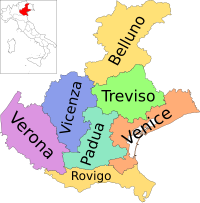Venice Province
Demography
Statistics recorded since 1871 show that the population of the province of Venice increased from some 341,000 inhabitants in 1871 to almost 847,000 in 2011. It rose steadily in each of the ten-year statistical periods until 1981 (reaching 838,794 inhabitants) whereafter there were declines until 2001 when the population dipped to 809,586. Finally, there was an increase of 4.6% in the ten-year period from 2001 to 2011 when the number of inhabitants reached 340,913.
The average age per inhabitant was 44.8 years in 2011, up from 35.6 years in 1981. In 2012, there were 72,284 foreigners residents in the province (up from 44,996 in 2006), mainly from Romania, Moldova and Albania, representing 8.5% of the total population. In the academic year 2012 to 2013, 23,677 students were enrolled at university of which 61.8% were women and 38.2% male. The most popular fields of study were economics, foreign languages, letters and philosophy, and architecture.
Comuni
There were 44 comuni (sg.: comune) in the province [1]. In 2005, the main comuni by population were:
| Comune | Population |
|---|---|
| Venice | 270,662 |
| Chioggia | 51,231 |
| San Donà di Piave | 40,899 |
| Mira | 37,737 |
| Mirano | 26,126 |
| Portogruaro | 25,162 |
| Spinea | 24,698 |
| Jesolo | 23,705 |
| Martellago | 19,904 |
| Scorzè | 18,626 |
| Santa Maria di Sala | 15,521 |
| Cavarzere | 15,319 |
| Noale | 15,237 |
| Dolo | 14,649 |
| Marcon | 12,969 |
| Eraclea | 12,653 |
| Cavallino-Treporti | 12,444 |
| Santo Stino di Livenza | 12,386 |
| Camponogara | 11,858 |
| Caorle | 11,847 |
| Salzano | 11,797 |
| San Michele al Tagliamento | 11,778 |
| Musile di Piave | 10,642 |
| Concordia Sagittaria | 10,641 |
Economy
Tourism was an important contributor to the provincial economy with over 26,000 establishments (including 1,277 hotels) offering overnight accommodation and accounting for a total of 34 million tourist nights spent in 2012 (down slightly from 2011 but substantially higher than some 29 million nights in 2002).
The gross domestic product of the province was 25 million euro in 2010, down slightly from 25.973 million euro in 2007. In 2012, the service sector represented 73% of the economy, while industry covered 19%, construction 7% and agriculture just 1%. Footwear represented 9.6% of provincial exports, petroleum products 7.2% and machinery 6.7%.
See also
References
- ^ "Censimenti popolazione prov. di Venezia 1861-2011" (in Italian). tuttitalia. Retrieved 29 September 2014.
- ^ "Legge 7 aprile 2014, n. 56: Disposizion sulle citta' metropolitane, sulle province, sulle unioni e fusioni di comuni. (14G00069)". Gazzetta Aufficiale della Repubblica Italiana. 2014-04-07. Retrieved 2021-06-09.
- ^ "Venezia in cifre 2013". Camera di Commercio Venenzia. Archived from the original on 7 December 2014. Retrieved 29 September 2014.
